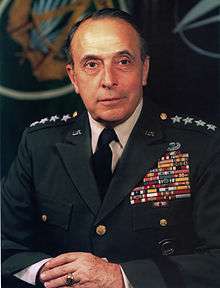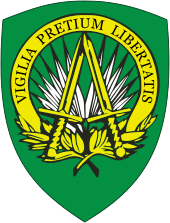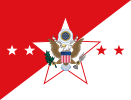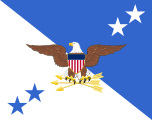Lyman Lemnitzer
Lyman Louis Lemnitzer (August 29, 1899 – November 12, 1988) was a United States Army general, who served as Chairman of the Joint Chiefs of Staff from 1960 to 1962. He then served as Supreme Allied Commander Europe of NATO from 1963 to 1969.
Lyman Lemnitzer | |
|---|---|
 General Lyman Louis Lemnitzer, United States Army | |
| Born | August 29, 1899 Honesdale, Pennsylvania |
| Died | November 12, 1988 (aged 89) Washington, D.C. |
| Buried | |
| Allegiance | United States |
| Service/ | United States Army |
| Years of service | 1916–1969 |
| Rank | General |
| Commands held | Supreme Allied Commander Europe Chairman of the Joint Chiefs of Staff Chief of Staff of the United States Army Eighth Army 7th Infantry Division 11th Airborne Division 34th Coast Artillery Brigade |
| Battles/wars | World War II Korean War |
| Awards | Army Distinguished Service Medal (4) Navy Distinguished Service Medal Air Force Distinguished Service Medal Silver Star Legion of Merit (2) |
| Other work | Rockefeller Commission |
Early life and education
Lemnitzer was born on August 29, 1899 in Honesdale, Pennsylvania. He was raised Lutheran,[1] and graduated from Honesdale High School in 1917. He then entered the United States Military Academy at West Point, from which he graduated in 1920 with a commission as a second lieutenant in the United States Army Coast Artillery Corps.
Early career
Lemnitzer graduated from the Coast Artillery School in 1921, and then served at Fort Adams in Rhode Island and in the Philippines. He was an instructor at West Point from 1926 to 1930.
Lemnitzer served again in the Philippines from 1934 to 1935, and graduated from the United States Army Command and General Staff College in 1936. He was an instructor at the Coast Artillery School, and graduated from the United States Army War College in 1940.
At the start of World War II Lemnitzer served with the 70th Coast Artillery Regiment and then the 38th Coast Artillery Brigade. In May 1941, Lemnitzer, then a colonel, was assigned to the War Plans Division of the Army staff, and then to the staff of the Army Ground Forces.
World War II
Lemnitzer was promoted to brigadier general in June 1942 and commanded the 34th Coast Artillery Brigade. He was subsequently assigned to General Dwight D. Eisenhower's staff, where he helped plan the invasions of North Africa and Sicily and was promoted to major general in November 1944. Lemnitzer was one of the senior officers sent to negotiate the Italian fascist surrender during the secret Operation Sunrise and the German surrender in 1945.
Post-World War II
Following the end of World War II, Lemnitzer was assigned to the Strategic Survey Committee of the Joint Chiefs of Staff and was later named Deputy Commandant of the National War College.
Korean War
In 1950, at the age of 51, Lemnitzer took parachute training and was placed in command of the 11th Airborne Division. He was assigned to Korea in command of the 7th Infantry Division in November 1951 and was promoted to lieutenant general in August 1952.
Post-Korean War
Lemnitzer was promoted to the rank of general and named commander of US Army forces in the Far East and of the Eighth Army in March 1955. He was named Chief of Staff of the United States Army in July 1957 and appointed Chairman of the Joint Chiefs of Staff in September 1960. As Chairman, Lemnitzer was involved in the Bay of Pigs crisis and the early years of United States involvement in the Vietnam War. He was also required to testify before the United States Senate Foreign Affairs Committee about his knowledge of the activities of Major General Edwin Walker, who had been dismissed from the Army over alleged attempts to promote his political beliefs in the military.
Lemnitzer approved the plans known as Operation Northwoods in 1962, a proposed plan to discredit the Castro regime and create support for military action against Cuba by staging false flag acts of terrorism and developing "a Communist Cuban terror campaign in the Miami area, in other Florida cities and even in Washington". Lemnitzer presented the plans to Secretary of Defense Robert McNamara on March 13, 1962. It is unclear how McNamara reacted, but three days later President John F. Kennedy told the general that there was no chance that the US would take military action against Cuba. Within a few months, after the refusal to endorse Operation Northwoods, Lemnitzer was denied another term as JCS chairman.[2]
In November 1962, Lemnitzer was appointed as commander of U.S. European Command, and as Supreme Allied Commander Europe of the North Atlantic Treaty Organisation (NATO). His time in command saw the Cyprus crisis of 1963–1964 and the withdrawal of NATO forces from France in 1966. As of 2015, Lemnitzer is the only Chairman of the Joint Chiefs to hold another U.S military command after his term as Chairman ended, rather than retiring.
Later life and death
Lemnitzer retired from the military in July 1969. His 14-year tenure as a four star general on active duty is the longest in the history of the U.S. Army. He was the only person in history to serve as Army Chief of Staff, Chairman of the Joint Chiefs of Staff and Supreme Allied Commander for NATO.
General Lemnitzer is one of only four officers in the history of the United States Army to have actively served as a general during three major wars (World War II, Korea and Vietnam). The others were Winfield Scott (War of 1812, Mexican War, Civil War), Douglas MacArthur (World War I, World War II and Korea) and Lewis Hershey (World War II, Korea, Vietnam).
In 1975, President Gerald Ford appointed Lemnitzer to the Commission on CIA Activities within the United States (aka the Rockefeller Commission) to investigate whether the Central Intelligence Agency had committed acts that violated US laws, and allegations that E. Howard Hunt and Frank Sturgis (of Watergate fame) were involved in the assassination of John F. Kennedy.
Lemnitzer died on November 12, 1988, and is buried in Arlington National Cemetery. His wife, Katherine Tryon Lemnitzer (1901–1994), is buried with him.[3]
Awards and decorations
Lemnitzer was awarded numerous military awards and decorations[4] including but not limited to:
 |
Distinguished Rifleman |
 |
Basic Parachutist Badge |
 |
SACEUR badge |
| Army Distinguished Service Medal with three oak leaf clusters | |
| Navy Distinguished Service Medal | |
| Air Force Distinguished Service Medal | |
| Silver Star | |
| Legion of Merit Degree of Officer | |
| Legion of Merit Degree of Legionnaire | |
| Presidential Medal of Freedom (Awarded by President Reagan, June 23, 1987) | |
| World War I Victory Medal | |
| American Defense Service Medal | |
| American Campaign Medal | |
| European-African-Middle Eastern Campaign Medal (with two campaign stars) | |
| World War II Victory Medal | |
| Army of Occupation Medal with "Germany" clasp | |
| National Defense Service Medal with oak leaf cluster | |
| Korean Service Medal (with two service stars) |
- Foreign decorations
| Grand Cross of the Légion d'Honneur (France) | |
| Knight of the Grand Cross of the Order of Merit of the Italian Republic (Italy) | |
| Grand Cross of the Military Order of Italy (Italy) | |
| Grand Cross of the Order of the Crown of Italy (Italy) | |
| Dutch Knight Grand Cross in the Order of Orange-Nassau, with Swords (Netherlands) | |
| Grand Officer of the Order of Boyaca (Colombia) | |
| Grand Cordon First Class of the Order of the Rising Sun (Japan) | |
| Grand Officer of the Order of Military Merit (Brazil) | |
| Order of Military Merit Teaguk (Korea) | |
| Order of Military Merit Teaguk with Gold Star (Korea) | |
| Order of National Security Merit Gugseon with Silver Star (Korea) | |
| Gold Cross of Merit with Swords (Poland) | |
| Philippine Legion of Honor, Chief Commander | |
| Knight Grand Cross of the Most Exalted Order of the White Elephant (Thailand) | |
| Royal Order of the White Eagle, Class II (Yugoslavia) | |
| Grand Star of Military Merit (Chile) | |
| Order of Menelik II (Ethiopia) | |
| Grand-Cross of the Portuguese Order of Aviz[5] | |
| Honorary Companion of the Most Honourable Order of the Bath (Great Britain) | |
| Honorary Commander of the Most Excellent Order of the British Empire (Great Britain) | |
| Croix de Guerre with bronze Palm (France) | |
| Bundeswehr Cross of Honour in Gold (Germany) | |
| Medal for Military Merit, First Class (Czechoslovakia) | |
| Republic of Korea Presidential Unit Citation | |
| United Nations Korea Medal | |
| Medalha de Guerra (Brazil) | |
| Korean War Service Medal |
Lemnitzer was a Freemason.
Dates of rank
| Insignia | Rank | Component | Date |
|---|---|---|---|
| No insignia | Cadet | United States Military Academy | June 14, 1918 |
| Second Lieutenant | Regular Army | July 2, 1920 | |
| First Lieutenant | Regular Army | June 9, 1925 | |
| Captain | Regular Army | August 1, 1935 | |
| Major | Regular Army | July 1, 1940 | |
| Lieutenant Colonel | Army of the United States | December 11, 1941 | |
| Colonel | Army of the United States | June 11, 1942 | |
| Brigadier General | Army of the United States | June 25, 1942 | |
| Lieutenant Colonel | Regular Army | July 2, 1943 | |
| Major General | Army of the United States | May 7, 1944 | |
| Brigadier General | Regular Army | January 24, 1948 | |
| Major General | Regular Army | August 6, 1951 | |
| Lieutenant General | Army of the United States | August 1, 1952 | |
| General | Army of the United States | March 25, 1955 | |
| General | Retired List | June 30, 1969 | |
References
- http://www.nndb.com/people/602/000172086/
- ABC News: U.S. Military Wanted to Provoke War With Cuba
- "Lyman Louis Lemnitzer". Find a Grave. Retrieved July 1, 2019.
- Richard Nixon: Remarks on Presenting the Distinguished Service Medals of the Army, Navy, and Air Force to General Lyman L. Lemnitzer. – July 11th, 1969
- "Cidadãos Estrangeiros Agraciados com Ordens Portuguesas". Página Oficial das Ordens Honoríficas Portuguesas. Retrieved 1 August 2017.
- Official Register of Commissioned Officers the United States Army, 1948. pg. 1068.
External links
| Wikimedia Commons has media related to Lyman Lemnitzer. |
- Finding aid for Lyman L. Lemnitzer Oral History, Dwight D. Eisenhower Presidential Library
- Official US Joint Chiefs of Staff Biography
| Military offices | ||
|---|---|---|
| Preceded by Williston B. Palmer |
Vice Chief of Staff of the United States Army 1957–1959 |
Succeeded by George Decker |
| Preceded by Maxwell D. Taylor |
Chief of Staff of the United States Army 1959–1960 | |
| Preceded by Nathan F. Twining |
Chairman of the Joint Chiefs of Staff 1960–1962 |
Succeeded by Maxwell D. Taylor |
| Preceded by Lauris Norstad |
Supreme Allied Commander Europe (NATO) 1963–1969 |
Succeeded by Andrew Goodpaster |


